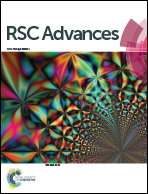Development and digestion of resistant malate starch produced by l-malic acid treatment
Abstract
Resistant starch (RS) modified by L-malic acid is a prebiotic that passes intact through the stomach and small intestine, and the optimum conditions determined using a response surface methodology (RSM) based on a Box–Behnken design (BBD) were: reaction temperature, 146 °C; pH, 1.46; reaction time, 5.52 h; and mass ratio (M : S), 0.60. After cooking at 100 °C, RS treated with L-malic acid contained substantial amounts of RS and slowly digestible starch (SDS) fractions (74.6%), although the rapid digestible starch (RDS) fraction still remained at about 25.4%. It was presumed that the decrease in the SDS content of the malate starch production treated by L-malic acid was because of the presence of RS or SDS type fractions formed by an amylose–malate complex substance and branch–branch or branch–linear interactions. The Fourier-transform infrared spectroscopy results showed that L-malic acid treated corn starch showed a novel band at 1732 cm−1, which was an indication of C![[double bond, length as m-dash]](https://www.rsc.org/images/entities/char_e001.gif) O stretching because of the corn starch linked with maleic anhydride.
O stretching because of the corn starch linked with maleic anhydride.


 Please wait while we load your content...
Please wait while we load your content...